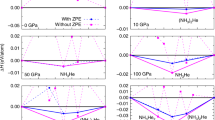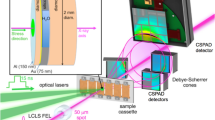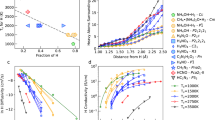Abstract
Under high pressures and temperatures, molecular systems with substantial polarization charges, such as ammonia and water, are predicted to form superionic phases and dense fluid states with dissociating molecules and high electrical conductivity. This behaviour potentially plays a role in explaining the origin of the multipolar magnetic fields of Uranus and Neptune, whose mantles are thought to result from a mixture of H2O, NH3 and CH4 ices. Determining the stability domain, melting curve and electrical conductivity of these superionic phases is therefore crucial for modelling planetary interiors and dynamos. Here we report the melting curve of superionic ammonia up to 300 GPa from laser-driven shock compression of pre-compressed samples and atomistic calculations. We show that ammonia melts at lower temperatures than water above 100 GPa and that fluid ammonia’s electrical conductivity exceeds that of water at conditions predicted by hot, super-adiabatic models for Uranus and Neptune, and enhances the conductivity in their fluid water-rich dynamo layers.
This is a preview of subscription content, access via your institution
Access options
Access Nature and 54 other Nature Portfolio journals
Get Nature+, our best-value online-access subscription
$29.99 / 30 days
cancel any time
Subscribe to this journal
Receive 12 print issues and online access
$209.00 per year
only $17.42 per issue
Buy this article
- Purchase on Springer Link
- Instant access to full article PDF
Prices may be subject to local taxes which are calculated during checkout




Similar content being viewed by others
Data availability
Data supporting this study are available in the Supplementary Information, from the online repository66 and from the corresponding author upon request.
Code availability
DFT simulations were performed with the proprietary code VASP.
Change history
16 June 2023
A Correction to this paper has been published: https://doi.org/10.1038/s41567-023-02130-3
References
Cavazzoni, C. et al. Superionic and metallic states of water and ammonia at giant planet conditions. Science 283, 44–46 (1999).
Hull, S. Superionics: crystal structures and conduction processes. Rep. Prog. Phys. 67, 1233–1314 (2004).
Mohn, C. E., Krynski, M., Kob, W. & Allan, N. L. Cooperative excitations in superionic PbF2. Philos. Trans. R. Soc. A 379, 20190455 (2021).
Boyce, J., Hayes, T. & Mikkelsen Jr, J. Extended-x-ray-absorption-fine-structure investigation of mobile-ion density in superionic AgI, CuI, CuBr, and CuCl. Phys. Rev. B 23, 2876–2896 (1981).
French, M., Desjarlais, M. P. & Redmer, R. Ab initio calculation of thermodynamic potentials and entropies for superionic water. Phys. Rev. E 93, 022140 (2016).
Bethkenhagen, M., French, M. & Redmer, R. Equation of state and phase diagram of ammonia at high pressures from ab initio simulations. J. Chem. Phys. 138, 234504 (2013).
French, M., Mattsson, T. R., Nettelmann, N. & Redmer, R. Equation of state and phase diagram of water at ultrahigh pressures as in planetary interiors. Phys. Rev. B 79, 054107 (2009).
Stanley, S. & Bloxham, J. Convective-region geometry as the cause of Uranus’ and Neptune’s unusual magnetic fields. Nature 428, 151–153 (2004).
Stanley, S. & Bloxham, J. Numerical dynamo models of Uranus’ and Neptune’s magnetic fields. Icarus 184, 556–572 (2006).
Redmer, R., Mattsson, T. R., Nettelmann, N. & French, M. The phase diagram of water and the magnetic fields of Uranus and Neptune. Icarus 211, 798–803 (2011).
Tian, B. Y. & Stanley, S. Interior structure of water planets: implications for their dynamo source regions. Astrophys. J. 768, 156 (2013).
Sugimura, E. et al. Experimental evidence of superionic conduction in H2O ice. J. Chem. Phys. 137, 194505 (2012).
Millot, M. et al. Experimental evidence for superionic water ice using shock compression. Nat. Phys. 14, 297–302 (2018).
Millot, M. et al. Nanosecond X-ray diffraction of shock-compressed superionic water ice. Nature 569, 251–255 (2019).
Queyroux, J.-A. et al. Melting curve and isostructural solid transition in superionic ice. Phys. Rev. Lett. 125, 195501 (2020).
Prakapenka, V. B., Holtgrewe, N., Lobanov, S. S. & Goncharov, A. F. Structure and properties of two superionic ice phases. Nat. Phys. 17, 1233–1238 (2021).
Weck, G. et al. Evidence and stability field of fcc superionic water ice using static compression. Phys. Rev. Lett. 128, 165701 (2022).
Sun, J., Clark, B. K., Torquato, S. & Car, R. The phase diagram of high-pressure superionic ice. Nat. Commun. 6, 8156 (2015).
Hernandez, J.-A. & Caracas, R. Superionic-superionic phase transitions in body-centered cubic H2O ice. Phys. Rev. Lett. 117, 135503 (2016).
Hernandez, J.-A. & Caracas, R. Proton dynamics and the phase diagram of dense water ice. J. Chem. Phys. 148, 214501 (2018).
Cheng, B., Bethkenhagen, M., Pickard, C. & Hamel, S. Phase behaviours of superionic water at planetary conditions. Nat. Phys. 17, 1228–1232 (2021).
Robinson, V. N., Wang, Y. C., Ma, Y. M. & Hermann, A. Stabilization of ammonia-rich hydrate inside icy planets. Proc. Natl Acad. Sci. USA 114, 9003–9008 (2017).
Robinson, V. N. & Hermann, A. Plastic and superionic phases in ammonia-water mixtures at high pressures and temperatures. J. Phys. Condens. Matter 32, 184004 (2020).
Ninet, S., Datchi, F. & Saitta, A. M. Proton disorder and superionicity in hot dense ammonia ice. Phys. Rev. Lett. 108, 165702 (2012).
Wang, Z.-Q. et al. Melting curve and transport properties of ammonia ice up to the deep mantle conditions of Uranus and Neptune. Phys. Rev. B 106, 014108 (2022).
Queyroux, J.-A. et al. Melting curve and chemical stability of ammonia at high pressure: combined x-ray diffraction and Raman study. Phys. Rev. B 99, 134107 (2019).
Kimura, T. & Murakami, M. Fluid-like elastic response of superionic NH3 in Uranus and Neptune. Proc. Natl Acad. Sci. USA 118, e2021810118 (2021).
Brygoo, S. et al. Analysis of laser shock experiments on precompressed samples using a quartz reference and application to warm dense hydrogen and helium. J. Appl. Phys. 118, 195901 (2015).
Brygoo, S. et al. Evidence of hydrogen–helium immiscibility at Jupiter-interior conditions. Nature 593, 517–521 (2021).
Hanson, R. & Jordan, M. Ultrahigh-pressure studies of ammonia. J. Phys. Chem. 84, 1173–1175 (1980).
Barker, L. M. & Hollenbach, R. E. Laser interferometer for measuring high velocities of any reflecting surface. J. Appl. Phys. 43, 4669–4675 (1972).
Celliers, P. M. et al. Line-imaging velocimeter for shock diagnostics at the OMEGA laser facility. Rev. Sci. Instrum. 75, 4916–4929 (2004).
Holmes, N. C. Fiber coupled optical pyrometer for shock wave studies. Rev. Sci. Instrum. 66, 2615–2618 (1995).
Miller, J. E. et al. Streaked optical pyrometer system for laser-driven shock-wave experiments on OMEGA. Rev. Sci. Instrum. 78, 034903 (2007).
Ravasio, A. et al. Metallization of shock-compressed liquid ammonia. Phys. Rev. Lett. 126, 025003 (2021).
Eggert, J. et al. Melting temperature of diamond at ultrahigh pressure. Nat. Phys. 6, 40–43 (2010).
Millot, M. et al. Shock compression of stishovite and melting of silica at planetary interior conditions. Science 347, 418–420 (2015).
Kormer, S. B. Optical study of the characteristics of shock-compressed condensed dielectrics. Sov. Phys. Uspekhi 11, 229–254 (1968).
Bethkenhagen, M. et al. Planetary ices and the linear mixing approximation. Astrophys. J. 848, 67 (2017).
Scheibe, L., Nettelmann, N. & Redmer, R. Thermal evolution of Uranus and Neptune-I. adiabatic models. Astron. Astrophys. 632, A70 (2019).
Naumova, A. S., Lepeshkin, S. V., Bushlanov, P. V. & Oganov, A. R. Unusual chemistry of the C-H-N-O system under pressure and implications for giant planets. J. Phys. Chem. A 125, 3936–3942 (2021).
Conway, L. J., Pickard, C. J. & Hermann, A. Rules of formation of H-C-N-O compounds at high pressure and the fates of planetary ices. Proc. Natl Acad. Sci. USA 118, e2026360118 (2021).
He, Z. et al. Diamond formation kinetics in shock-compressed C-H-O samples recorded by small-angle x-ray scattering and x-ray diffraction. Sci. Adv. 8, eabo0617 (2022).
Robinson, V. N., Marques, M., Wang, Y. C., Ma, Y. M. & Hermann, A. Novel phases in ammonia-water mixtures under pressure. J. Chem. Phys. 149, 234501 (2018).
French, M., Mattsson, T. R. & Redmer, R. Diffusion and electrical conductivity in water at ultrahigh pressures. Phys. Rev. B 82, 174108 (2010).
Schwegler, E., Galli, G., Gygi, F. & Hood, R. Q. Dissociation of water under pressure. Phys. Rev. Lett. 87, 265501 (2001).
Goldman, N. et al. Ab initio simulation of the equation of state and kinetics of shocked water. J. Chem. Phys. 130, 124517 (2009).
Soderlund, K. M. & Stanley, S. The underexplored frontier of ice giant dynamos. Philos. Trans. R. Soc. A 378, 20190479 (2020).
Duarte, L. D., Gastine, T. & Wicht, J. Anelastic dynamo models with variable electrical conductivity: an application to gas giants. Phys. Earth Planet. Inter. 222, 22–34 (2013).
Borucki, W. J. Kepler: a brief discussion of the mission and exoplanet results. Proc. Am. Philos. Soc. 161, 38–65 (2017).
Ninet, S. et al. Experimental and theoretical evidence for an ionic crystal of ammonia at high pressure. Phys. Rev. B 89, 174103 (2014).
Ninet, S. & Datchi, F. High pressure–high temperature phase diagram of ammonia. J. Chem. Phys. 128, 154508 (2008).
French, M. & Redmer, R. Electronic transport in partially ionized water plasmas. Phys. Plasmas 24, 092306 (2017).
Nettelmann, N. et al. Uranus evolution models with simple thermal boundary layers. Icarus 275, 107–116 (2016).
Dewaele, A., Torrent, M., Loubeyre, P. & Mezouar, M. Compression curves of transition metals in the mbar range: experiments and projector augmented-wave calculations. Phys. Rev. B 78, 104102 (2008).
Datchi, F., Dewaele, A., Godec, Y. L. & Loubeyre, P. Equation of state of cubic boron nitride at high pressures and temperatures. Phys. Rev. B 75, 214104 (2007).
Qi, T., Millot, M., Kraus, R. G., Root, S. & Hamel, S. Optical and transport properties of dense liquid silica. Phys. Plasmas 22, 062706 (2015).
Kresse, G. & Hafner, J. Ab initio molecular dynamics for liquid metals. Phys. Rev. B 47, 558–561 (1993).
Kresse, G. & Hafner, J. Ab initio molecular-dynamics simulation of the liquid-metal–amorphous-semiconductor transition in germanium. Phys. Rev. B 49, 14251–14269 (1994).
Kresse, G. & Furthmüller, J. Efficient iterative schemes for ab initio total-energy calculations using a plane-wave basis set. Phys. Rev. B 54, 11169–11186 (1996).
Perdew, J. P., Burke, K. & Ernzerhof, M. Generalized gradient approximation made simple. Phys. Rev. Lett. 77, 3865–3868 (1996).
Nosé, S. A unified formulation of the constant temperature molecular dynamics methods. J. Chem. Phys. 81, 511–519 (1984).
Baldereschi, A. Mean-value point in the Brillouin zone. Phys. Rev. B 7, 5212–5215 (1973).
Heyd, J., Scuseria, G. E. & Ernzerhof, M. Hybrid functionals based on a screened Coulomb potential. J. Chem. Phys. 118, 8207–8215 (2003).
Heyd, J., Scuseria, G. E. & Ernzerhof, M. Hybrid functionals based on a screened Coulomb potential. J. Chem. Phys. 118, 8207 (2003); erratum 124, 219906 (2006).
Hernandez, J.-A. Melting curve of superionic ammonia at planetary interior conditions. OSF https://doi.org/10.17605/OSF.IO/DETZM (2023).
Acknowledgements
We acknowledge the crucial contribution of the LULI2000 laser and support teams to the success of the experiments. We also thank S. Brygoo and P. Loubeyre for useful discussions. This research was supported by the French National Research Agency (ANR) through the projects POMPEI (grant no. ANR-16-CE31-0008) and SUPER-ICES (grant ANR-15-CE30-008-01), and by the PLAS@PAR Federation. M.F. and R.R. gratefully acknowledge support by the DFG within the Research Unit FOR 2440. M.B. was supported by the European Union within the Marie Skłodowska-Curie actions (xICE grant 894725) and the NOMIS foundation. The DFT-MD calculations were performed at the North-German Supercomputing Alliance facilities.
Author information
Authors and Affiliations
Contributions
J.-A.H., A.R., S.N. and F.D. designed the project and the experiments. F.D., S.N., F.O., J.-A.H. and A.R. designed the DAC targets, and J.-A.H., S.N., F.D., F.L. and F.O. prepared them. J.-A.H., A.R., A.B.-M., M.G. and T.V. performed the dynamic compression experiments. J.-A.H. analysed the experimental data. M.B. and M.F. designed, performed and analysed the DFT-MD simulations. All authors discussed the data. J.-A.H., M.B. and A.R. wrote the manuscript, and all authors commented on it and improved it.
Corresponding authors
Ethics declarations
Competing interests
The authors declare no competing interests.
Peer review
Peer review information
Nature Physics thanks David Stevenson, Kenji Ohta and the other, anonymous, reviewer(s) for their contribution to the peer review of this work.
Additional information
Publisher’s note Springer Nature remains neutral with regard to jurisdictional claims in published maps and institutional affiliations.
Supplementary information
Supplementary Information
Supplementary Sections S1–S7, Figs. S1–S9 and Tables S1–S3.
Rights and permissions
Springer Nature or its licensor (e.g. a society or other partner) holds exclusive rights to this article under a publishing agreement with the author(s) or other rightsholder(s); author self-archiving of the accepted manuscript version of this article is solely governed by the terms of such publishing agreement and applicable law.
About this article
Cite this article
Hernandez, JA., Bethkenhagen, M., Ninet, S. et al. Melting curve of superionic ammonia at planetary interior conditions. Nat. Phys. 19, 1280–1285 (2023). https://doi.org/10.1038/s41567-023-02074-8
Received:
Accepted:
Published:
Issue Date:
DOI: https://doi.org/10.1038/s41567-023-02074-8
This article is cited by
-
Double superionicity in icy compounds at planetary interior conditions
Nature Communications (2023)
-
Ammonia and the ice giants
Nature Physics (2023)



